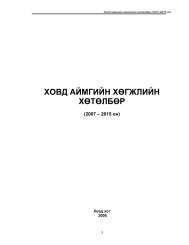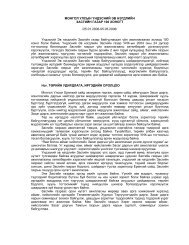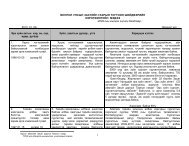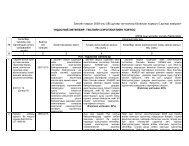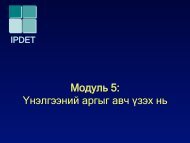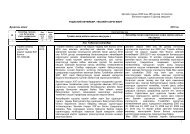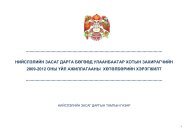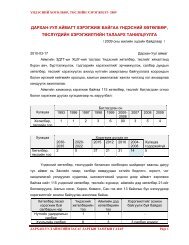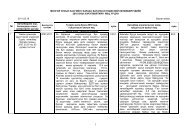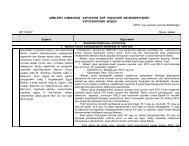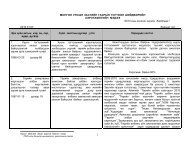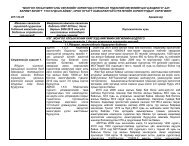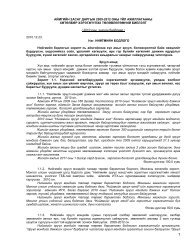монгол ÑлÑÑн мÑÐ½Ð³Ð°Ð½Ñ Ñ Ñгжлийн зоÑилÑод ÑÑÑÑилÑан vндÑÑний ...
монгол ÑлÑÑн мÑÐ½Ð³Ð°Ð½Ñ Ñ Ñгжлийн зоÑилÑод ÑÑÑÑилÑан vндÑÑний ...
монгол ÑлÑÑн мÑÐ½Ð³Ð°Ð½Ñ Ñ Ñгжлийн зоÑилÑод ÑÑÑÑилÑан vндÑÑний ...
- No tags were found...
You also want an ePaper? Increase the reach of your titles
YUMPU automatically turns print PDFs into web optimized ePapers that Google loves.
• Opportunities for software production and export created, consumption increased.• 20-30 thousand households in ger districts of the capital city connected to the central public utility systems;nationwide average of 10 thousand households improved their housing conditions annually.• Agricultural production and food supplies for population improved.• Livestock breeding quality improved by using biotechnology and genetic engineering, harvest of cropsincreased. Average annual wheat production increased fourfold, average annual production of potatoes andvegetables increased 1.5 times.• In infrastructure significant objectives achieved, the length of paved roads reached 8 thousand km. Constructionof railroad in Gobi and Eastern region accomplished by 60 percent. 70 percent of the construction work of thesecond railroad completed. Electrification of the main railroad resolved.• All soums of Mongolia have permanent power supply, all herder households supplied with solar and windenergy. Domestic power needs fully met and export of electricity started.• Regional development intensified and excessive concentration of population in Ulaanbaatar eased. Populationof some main regional centers no less than 50 thousand inhabitants.• Emergence of modern towns with population of 10-20 thousand inhabitants alongside large strategic deposits,such as Tavantolgoi and Oyu Tolgoi.• Family strengthened and population increased. Comprehensive measures to eradicate domestic violence taken.• Enrollment of children in primary education reached 99.1 percent, in secondary education - 97.2 percent and inbasic education - 98.3 percent.• Number of state or non-state owned general education school centers corresponding to or nearing theinternational standards to be more than 10.• Have more than two universities, nearing the international standards.• Family doctor system fully taken root.• 60 percent of soum and aimag hospitals and 100 percent of the district hospitals equipped with treatment anddiagnostics equipment.• Medical case records 100 percent transferred to electronic files.• Number of patients from rural areas arriving for diagnostics decreased by more than 50 percent.• A treatment and diagnostics center that meets international standards established, number of patients goingoversees for treatment and diagnostics noticeably decreased.• Accessibility and quality of medical services reached 75 percent.• Air pollution in Ulaanbaatar and other big cities fully eliminated. Comprehensive management of garbage andwaste implemented, thus sharply decreasing sources of environmental pollution.• The size of territories of special significance for preservation of the ecosystem balance of Mongolia enlarged tono less than 20 percent of the total territory, i.e. more than 30 million hectares.• Drinking water needs of the 70 percent of the urban population and 60 percent of the rural population met.Transition to a knowledge-based economy (2016-2021)• At this stage average annual economic growth no less than 12 percent, GDP per capita no less than USD 12thousand, knowledge-intensive industry and services expanded, knowledge-based economy developed,Mongolia became a middle-income country.• Mongolian economy as a whole efficient and competitive.• Shift from extraction of mineral resources to production of end products accelerated.• Average of no less than 15 thousand households improved their housing conditions nationwide annually.• Middle-income citizens constituted 60 percent of the total population.• Enrollment at all school levels reached 100 percent.• Number of schools and universities with curriculum fully corresponding to international standards increased.• Financing of research work reached 2 percent of GDP in 2015 and 3 percent of GDP in 2021. One-third ofthese expenses shouldered by the private sector.• Mongolia became a country that adopted and mastered modern technology.• Tourism developed, number of tourists visiting Mongolia a year equaled the country’s population.• Intensive farming developed, food needs of the population satisfied mainly by domestic ecologically cleanproducts, export of food products increased.• Consumption of oil products fully supplied by domestic production.• Modern transportation, communication and energy infrastructure, competitive in the region and in Asia, created.Length of paved roads reached 11 thousand km. Exploitation of second railway started, a railroad network inWestern, Gobi and Eastern regions established.• Mongolia fully and reliably met its power, heating and energy needs from domestic sources, and became asupplier of electricity to the world market.• Regional main centers developed, their population reached no less than 100 thousand people each, favorableconditions created for people to enjoy stable lives and work in their localities.• Average life expectancy reached 72.32



